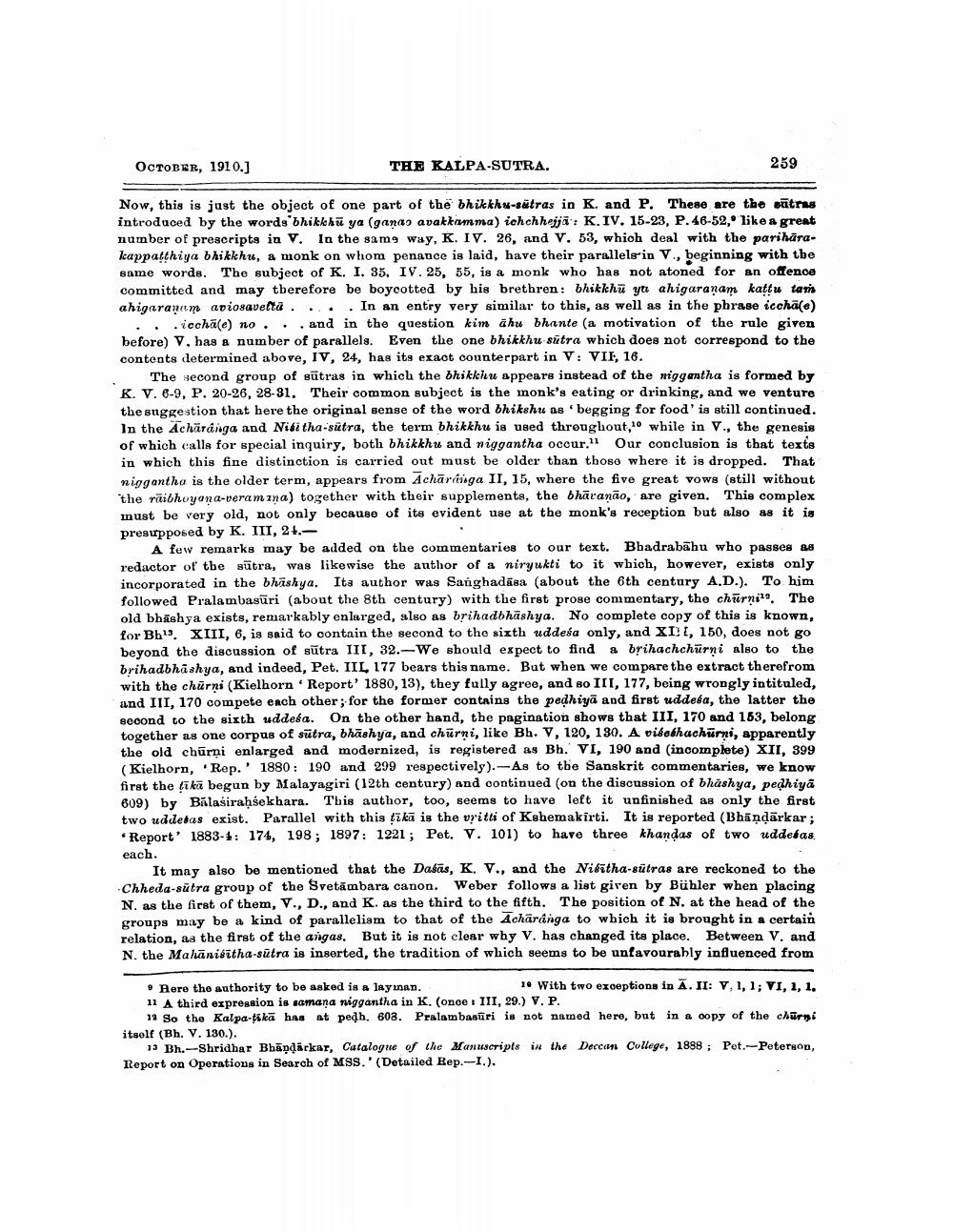________________
OCTOBER, 1910.]
THE KALPA-SUTRA.
259
Now, this is just the object of one part of the bhikkhu-sätras in K. and P. These are the sātnes introduced by the words bhikkhū ya (gana, avakkamma) ichchhejjā: K. IV. 15-23, P. 46-52, like a great number of prescripts in V. In the same way, K. IV. 26, and V. 53, which deal with the parihārakappalthiya bhikkhu, a monk on whom penance is laid, have their parallels in V., beginning with the same words. The subject of K. I. 35. IV. 25, 55, is a monk who has not atoned for an offence committed and may tberefore be boycotted by his brethren: bhikkhu ytı ahigaranam kattu tam ahigaranam adiosavetta . ...In an entry very similar to this, as well as in the phrase iccha(e)
...icchā(e) no ... and in the question kim āhu bhante (a motivation of the rule given before) V, has a number of parallels. Even the one bhikkhu sūtra which does not correspond to the contents determined above, IV, 24, has its exact counterpart in V: VII, 16.
The second group of sütras in which the bhikkhu appears instead of the niggantha is formed by K. V. 6-9, P. 20-26, 28-31. Their common subject is the monk's eating or drinking, and we venture the suggestion that here the original sense of the word bhikshu as 'begging for food' is still continued. In the Achāranga and Nisi tha-sutra, the term bhikkhu is used throughout, while in V., the genesis of which calls for special inquiry, both bhikkhu and niggantha occur. Our conclusion is that texts in which this fine distinction is carried out must be older than those where it is dropped. That niggantha is the older term, appears from Achārasiga II, 15, where the five great vows (still without the raibhoyona-veram mna) together with their supplements, the bhāranco, are given. This complex must be very old, not only because of its evident use at the monk's reception but also as it is presupposed by K. III, 2.
A few remarks may be added on the commentaries to our text. Bhadrabāhu who passes as redactor of the sutra, was likewise the author of a niryukti to it which, however, exists only incorporated in the bhashya. Ita author was Sanghadāsa (about the 6th century A.D.). To him followed Pralambasüri (about the 8th century) with the first prose commentary, the churni19. The old bhāshya exists, remarkably enlarged, also as brihadbhāshya. No complete copy of this is known, for Bh's. XIII, 6, is said to contain the second to the sixth uddesa only, and XII, 150, does not go beyond the discussion of sutra III, 32.-We should expect to find a brihachchürni also to the brihadbhashya, and indeed, Pet. IIL 177 bears this name. But when we compare the extract therefrom with the churni (Kielhorn Report' 1880, 13), they fully agree, and so III, 177, being wrongly intituled, and III, 170 compete each other; for the former contains the pedhiyā and first uddeba, the latter the second to the sixth uddeka. On the other hand, the pagination shows that III, 170 and 163. belong together as one corpus of sūtra, bhāshya, and churni, like Bh. V, 120, 130. A vibokhachurni, apparently the old chūrni enlarged and modernized, is registered as Bh. VI, 190 and (incomplete) XII, 399 (Kielhorn, Rep.' 1880: 190 and 299 respectively).-As to the Sanskrit commentaries, we know first the lika begun by Malayagiri (12th century) and continued (on the discussion of bhashya, pedhiyā 809) by Bálasiraḥsekhara. This author, too, seems to have left it unfinished as only the first two uddetas exist. Parallel with this tikā is the vritti of Kshemakirti. It is reported (Bhāndārkar: *Report' 1883-1: 174, 198; 1897: 1221; Pet. V. 101) to have three khandas of two uddelas, each.
It may also be mentioned that the Daśās, K. V., and the Nifitha-sútras are reckoned to the Chheda-sutra group of the Svetambara canon. Weber follows a list given by Bühler when placing N. as the first of them, V., D., and K. as the third to the fifth. The position of N. at the head of the groups may be a kind of parallelism to that of the Achärdiga to which it is brought in a certain relation, as the first of the angas. But it is not clear why V. has changed its place. Between V. and N. the Mahānisītha-sūtra is inserted, the tradition of which seems to be unfavourably influenced from
. Here the authority to be asked is a layanan.
1. With two exceptions in A. II: V, 1, 1; VI, 1, 1, 11 A third expression is samana niggantha in K. (once III, 29.) V. P.
12 So the Kalpa-ţikā has at pedh, 603. Pralambasūri is not named here, but in a copy of the churni itself (Bh. V. 130.).
13 Bh.-Shridhar Bhāņdārkar, Catalogue of the Manuscripts in the Deccan College, 1888 ; Pet.-Peterson, Report on Operations in Search of MSS. (Detailed Rep.-I.).




